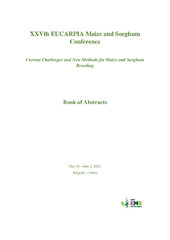Приказ основних података о документу
circRNAs involved in chilling stress response during early developmental stages in maize
| dc.creator | Božić, Manja | |
| dc.creator | Ignjatović-Micić, Dragana | |
| dc.creator | Vančetović, Jelena | |
| dc.creator | Delić, Nenad | |
| dc.creator | Nikolić, Ana | |
| dc.date.accessioned | 2023-04-07T11:49:46Z | |
| dc.date.available | 2023-04-07T11:49:46Z | |
| dc.date.issued | 2022 | |
| dc.identifier.isbn | 978-86-80383-15-6 | |
| dc.identifier.uri | http://rik.mrizp.rs/handle/123456789/1139 | |
| dc.description.abstract | Circular RNAs (circRNAs) are endogenous, single-stranded, covalently closed RNA molecules, generated by back-splicing events. Their role as regulators of different processes in animal cells has been widely studied and proven, however functional studies on circRNAs in plants are still few and far between. Here we attempt to bring light to their role in abiotic stress response – particularly chilling stress, in young maize seedlings (Zea mays L.) using high-throughput sequencing methods. One of the strategies of avoiding yield loss is earlier maize sowing as to escape exposure to extremely high temperatures and drought in the summer. This means submitting maize plants to suboptimal temperatures during earlier developmental stages. Two maize inbred lines of contrasting tolerance to chilling were selected and marked as LT (tolerant), and LS (sensitive). Sterilized seeds of the two lines were germinated for five days, in the dark, in optimal conditions and after the germination period was finished, the 5-d old seedlings were exposed to chilling conditions for 24h (temperature: 10/8° C; photoperiod: 12/12h). Sampling was done after 6h and 24h of treatment. After total RNA isolation and purification, quality check, and cDNA library preparations were finished, paired-end 150 sequencing was performed (Illumina® Novaseq 6000). Custom pipeline was used for circRNAseq data analysis and included their identification and quantification (CIRCexplorer2, v2.0.5), differential expression analysis (edgeR Bioconductor v4.1) and functional enrichment (GO, KEGG, psRobot). Processing of this data is still underway, and by now several thousand circRNA molecules and over a thousand 5' and 3' alternative back-splicing sites have been identified. Significant number of those circRNA have shown expression dependent on chilling, as well as genotype, but further studies are necessary to confirm their role in this process, find their target molecules and unravel regulatory networks they create with other types of RNAs. | sr |
| dc.language.iso | en | sr |
| dc.rights | openAccess | sr |
| dc.rights.uri | https://creativecommons.org/licenses/by/4.0/ | |
| dc.source | 25. EUCARPIA Maize and Sorghum conference current, Challenges and new methods for maize and sorghum breeding, 30.05–2.06.2022., Belgrade, Serbia - Book of abstracts | sr |
| dc.subject | circRNAs | sr |
| dc.subject | chilling | sr |
| dc.subject | abiotic stress | sr |
| dc.subject | RNAseq | sr |
| dc.title | circRNAs involved in chilling stress response during early developmental stages in maize | sr |
| dc.type | lecture | sr |
| dc.rights.license | BY | sr |
| dc.identifier.fulltext | http://rik.mrizp.rs/bitstream/id/6121/bitstream_6121.pdf | |
| dc.identifier.rcub | https://hdl.handle.net/21.15107/rcub_rik_1139 | |
| dc.type.version | publishedVersion | sr |


